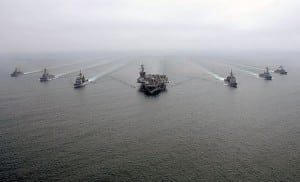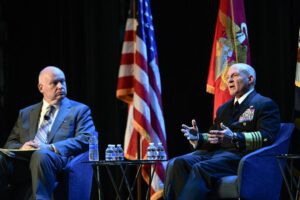The Chief of Naval Operations (CNO) this week said the Navy’s Project Overmatch is set to go to Pacific region naval forces once testing on the Carl Vinson Strike Group wraps up.
Adm. Mike Gilday first directed Naval Information Warfare Systems Command to lead the secretive Project Overmatch in 2020. The project aims to build a new naval operational infrastructure to help manned and unmanned forces operate in a distributed manner and create a common operating picture to best match sensors and shooters (
Defense Daily, Oct. 15, 2020).

Project Overmatch is also the Navy’s contribution to the overall Defense Department’s Joint All-Domain Command and Control (JADC2) effort to better connect all the military’s networks, sensors and shooters and sensors.
Speaking at a Brookings Institution event on June 7, Gilday reiterated Project Overmatch generally aims to containerize Navy data and send it over any network.
“So instead of building a whole new operational infrastructure, it’s to basically leverage what we have, primarily leveraging commercial technology and just pivoting it to a military use,” the CNO said.
He compared the technology the Navy is using to how a handheld smartphone instantly switches from Wi-Fi to a carrier 3G/4G internet service when it leaves the boundaries of the former.
“So it’s the same type of thinking, so it’s actually software controlled, software defined in terms of prioritizing what data’s most important and where it ends and by what path. So we’ve had great success in leveraging some great technologies from industry.”
In April, Gilday said Project Overmatch testing was “in full swing” with the eight ships in the USS Carl Vinson (CVN-70) Carrier Strike Group off the cast of California and the service planned to scale up the effort in the following months (Defense Daily, April 3).
At the time, he said the results of the experiments will inform next steps in the project expansion, but he declined to say where the Navy is going next with Project Overmatch other than they are still on schedule and on track with objectives.
However, this week the CNO said confirmed expansion into the Pacific region is next with cooperation with several allies.
On Wednesday, Gilday said the next steps “likely will focus on the Pacific first and then expand globally into our other fleets. We are also working closely with some key allies and partners with respect to this – most notably I would think would be the Australians, the French and the Brits.”

He said the systems and participants will expand over time as the Navy learns more every say, “but we still have more work to do.”
When pressed, Gilday confirmed that Pacific expansion will include the U.S. 7th Fleet.
“Yes, in the Pacific. And again it’s a DevOps kind of environment so we’re learning as we’re doing.”
In January 2022, Rear Adm. James Downey, program executive officer for aircraft carriers, confirmed there are four carriers the Navy is working on to introduce the Project Overmatch capabilities (Defense Daily, Jan. 25, 2022).
Before that, in 2021 Vice Adm. James Kilby, then-Deputy Chief of Naval Operations for Warfighting Requirements and Capabilities, said the Navy planned to deliver a minimally viable product of Project Overmatch onto the Theodore Roosevelt Carrier Strike Group (TRCSG) in fiscal year 2023 (Defense Daily, Feb. 9, 2021).
Also in 2021 Gilday said the Navy expected Project Overmatch to undergo four increasingly complex spirals that year, with deployment on an initial carrier strike group in late 2022 or early 2023 (Defense Daily, April 6, 2021).